Coconutty Black-Eyed Peas and Rice Pudding, a cozy southern Viet favorite
here's a recipe that's better than what you'd get from a street vendor, IMHO!
We traveled to Nashville this week for me to speak at the Les Dames d’Escoffier writing symposium but before leaving the house, I had to cook up a recipe for you. It’s a follow-up to my recent posts on grocery shopping and cooking in Saigon plus where to eat while you’re in Ho Chi Minh City.
After the dispatch went out, I thought of a particular street food that I’d not had a chance to try — a creamy, not-too-sweet black-eyed peas and sticky rice coconut pudding (chè đậu trắng). It’s a perennial favorite that comes together pretty easily.
Here’s a summary of how it went down:
Wait up — What is Chè?
This is where you and I may have a cultural divide. Western sweets rarely touch upon sweet soups, but that’s what chè is. They are desserts that you eat with a spoon and can be soupy, iced, or thick and ploppable. Why eat soup for dessert? Because it’s delicious!
Countless Asians eat sweet soups.
In the Vietnamese repertoire, chè (“ch-EY”) is a broad category of sweet snacks that may be enjoyed warm, cold (with crushed ice), or at room temperature. They are generally light and what you’d feel eat after a meal. They are typically the purview of street vendors and doting moms, aunties, and grandmas. The chè shop is the Viet equivalent of an ice cream or frozen yogurt shop. You can pick and choose ingredients to make your own, or select a classic like this one.
When chè is made well, you can parse the individual ingredients as well as savor their combined synergy. Beans are usually involved for texture and nutrition. There are sometimes elements of traditional Chinese medicine (TCM) too.
Street Vendor version of Chè Đậu Trắng
A melange of black-eyed peas, sticky rice and sweetened coconut sauce, this pudding-ish ditty isn’t TCM. It’s just dleightful.
Because I missed getting the pudding from a Saigon vendor, I wanted to at least watch one. Want to make something well? Check out a pro. This YouTube video lacks narration and doesn’t even identify the street vendor, but it whet my appetite and also gave me clues about the ideal texture of the rice and beans.
Note that the texture of the rice and black-eyed peas is ideally very soft and easily scoopable. To get sticky rice to hold that way means the rice is cooked in a different rice to water ratio. I kept that in mind when developing this recipe.
Why you should make this
Chè đậu trắng is a Viet classic with many positive attributes, such as:
It’s cozy, loveable, and doable with accessible ingredients
Extends your use of that bag of sticky rice I made you buy (also use it for Saigon-style grilled bananas in sticky rice; Hanoi-style sticky rice, mung beans and fried shallots; master microwave sticky rice, and sticky rice and chestnut stuffing)
It’s naturally gluten-free, dairy free, low sugar, and vegan
Can be made days in advance, even eaten straight from the fridge
Makes interesting cultural connections
May get you to explore and use pandan, one of my favorite ingredients!
In this post you’ll get a little more background info, ingredient and technical tips, plus the detailed recipe with swaps. A downloadable recipe PDF is included too!
Black-Eyed Pea Options
Originally from West Africa, black-eyed peas are not a go-to legume like soybeans, mung beans, or adzuki beans. Vietnam uses them mostly for this one dish. There are French-inspired bean dishes that use white flageolet-type beans but I’ve not seen them call for black-eyed peas. It’s unclear how black-eyed peas became popular in Vietnam, but they were grown in China and India by 1500 BC.
Viet people call black-eyed peas đậu trắng (“bean white”) but they cook up a pale beige color. That’s white enough, yes?
I used dried beans but also tried frozen ones. The frozen ones were a bust and more expensive. On the right, look at all the skins that I had to fish out and many of the beans were split from processing.
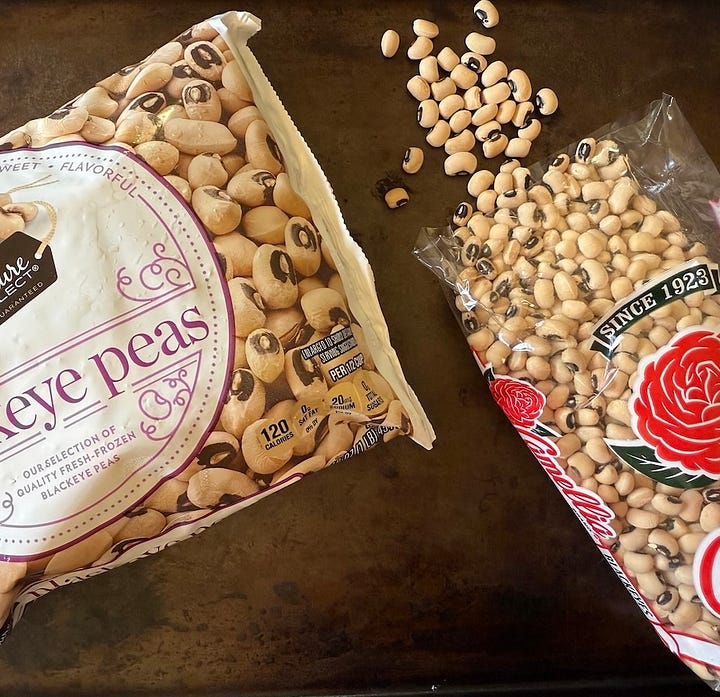
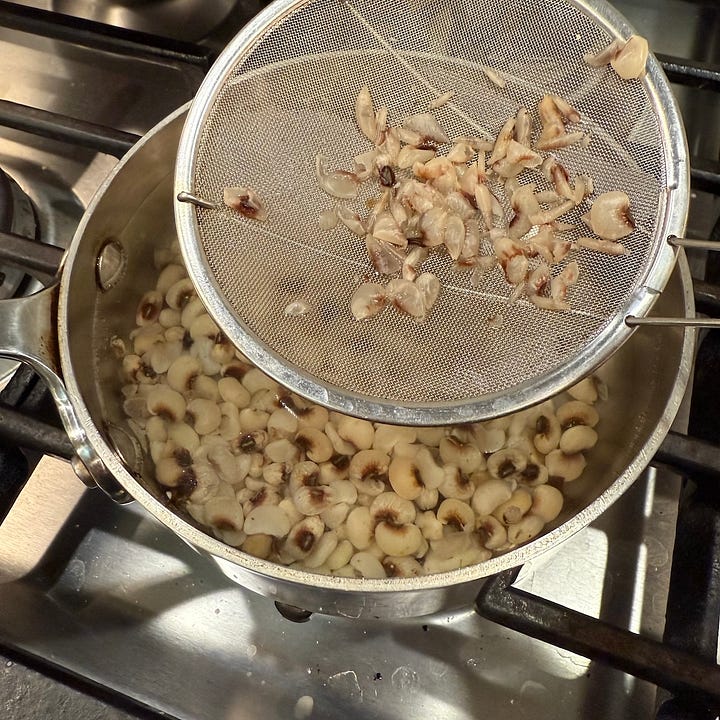
You can soak dried beans first but I lacked patience the other morning and pressure cooked them on the stove. A stovetop cooker makes it easier to control the heat and depressurizes faster than an Instant Pot — key for the beans in this recipe because you want beans that keep their shape. I chose to use my T-Fal Trendy pressure cooker, which has proven to be a champ for my weekly meal prep (soup broth, steamed beets, and beans!).
If you have fresh black eye peas, by all means, boil up about 2 1/2 to 3 cups for this recipe. Your chè will be DELUXE. I chose Camellia brand of beans because they’re one of my favorite brands and grown in the American South.
Use Pandan or Not?
Pandan (lá dứa, screwpine) is widely used in Southeast Asia for savories and sweets. For instance, aside from delicately flavoring sticky rice, it’s color and flavor defines many classic pandan chiffon cakes (including my recipe).
🍃 For the pandan lowdown, look to my pandan leaf primer for information on:
What the leaves are
How they are used in Asian kitchens
Options for sourcing fresh, thawed, dried, and extract
Tips on storing and making pandan liquid for recipes
I used handy dried pandan for this recipe and it was great; I also made a tea with the leaves to enjoy with the chè. You can fudge pandan flavor with vanilla but if you combine pandan and vanilla, the result will have much more depth.
Rice & bean texture tip
You’ll notice a funny thing that happens with the rice and bean texture at the end of cooking: It slowly moves as a blob in the pan. That’s what you want. I was so tickled by it that I made this video for you:
Alright — that’s enough of my selling you on this marvelously easy recipe. It’s so good I just ate a spoonful of leftovers from the fridge. Go for it!
RECIPE
Black-Eyed Peas and Sticky Rice Pudding | Chè Đậu Trắng
Before you get cooking . . .
✅ You can make the rice and beans and sauce up to 5 days ahead. Warm in the microwave oven or on the stove, if needed before assembling. I’m pretty sure you can freeze them for at least a month.
✅ No sticky rice in your pantry yet? Cook up sushi rice. The texture will not be as plush as when made with sticky rice but you’ll have a sense of this sweet treat.
✅ No rice flour? Use a clean coffee grinder to blitz a good 2 Tbsp of raw rice grains as fine as possible then measure what you need.
✅ Want to make pandan water from thawed or fresh leaves? Snip 12 to 15 thawed leaves (or 5 to 6 large fresh leaves) and blend with 1 cup water to smithereens. Then squeeze the heck out of it for the liquid. I use dried pandan.
✅ Combining palm sugar and organic granulated sugar yields a sweetness that mimics the soulful flavor of what you taste in Southeast Asia.
Serves 6 to 8
Ingredients
8 oz dried black-eye peas
1/4 tsp baking soda (help tenderizes)
Fine sea salt
2g | 1/4 cup packed dried pandan leaves, cut as pieces
135g | 2/3 cup sticky (glutinous/sweet) rice, any kind sold at Asian markets
240ml | 1 cup coconut water, plus more as needed
400ml | 13.5 oz can coconut milk (1 2/3 cups)
Vanilla extract, to taste
Up to 1/3 cup granulated sugar, preferably organic
3 Tbsp Thai palm sugar (optional for great flavor)
2 tsp tapioca starch
2 Tbsp rice flour (optional, see Note)
1/4 cup coconut flakes, toasted (optional)
Instructions
Cook the beans: Put the dried beans and baking soda in a stovetop pressure cooker. Add water to cover by about 2 knuckles (2 inches, 5cm). Lock the lid on and bring to low pressure over medium-high heat. Lower the heat to between medium and medium low to steadily whoosh for 18 minutes.
Turn off the heat, slide the cooker to a cool burner and let naturally depressurize. Drain the beans, rinse with cold water, then drain well. Put into a bowl and season with 1/2 tsp salt. (Alternatively, use an Instant Pot on low pressure for 16 minutes, or simmer the beans in the water on the stove, partially covered, until tender, 1 to 1 1/2 hours.) Makes about 3 cups.
Cook the coconut sticky rice: If using dried pandan leaves, hydrate them in 1 cup of just-boiled water for 15 to 20 minutes. Drain into a 3-quart (3L) pot. (When not using the pandan, put 1 cup water into the pot.)
Wash and drain the rice, then add to the pot with 1/4 tsp salt, 1/3 cup (80ml) coconut water, and 3/4 cup (180ml) of the coconut milk. Reserve the extra coconut water and milk.
Bring to a vigorous bubbling over medium-high, lower the heat slightly, then use a silicon spatula to stir frequently for 2 to 3 minutes, until the mixture thickens from the rice plumping up. Turn the heat to low, cover and cook for 10 minutes, stirring 2 times part way through to prevent scorching. When done, turn the heat off. Season the rice with 2 Tbsp sugar (all granulated sugar or 50/50 granulated and palm sugar).
Stir, scoop and fold the rice, adding about half of the remaining coconut water to loosen. Season the rice with 2 Tbsp of sugar (all granulated or 50/50 granulate and palm sugar). If you want to boost the pandan quality or if you did not use pandan, stir in vanilla by the 1/8 to 1/4 tsp.
With a light hand, incorporate the beans, stirring, scooping and folding to avoid mushing too many beans. Work in coconut water (or regular water if you ran out) by the 1 Tbsp to create a soft texture; the blob of rice and beans should move slowly when the pot is tilted. Cover and set aside.
Make the sauce: Put the rice flour in a small saucepan. Whisk in 2/3 cup (160ml) of coconut water, followed by the remaining scant 1 cup (220ml) coconut milk. Add ¼ tsp salt and 3 Tbsp sugar (all granulated or 50/50 granulate and palm sugar). Spoon out 2 Tbsp of the mixture into a small bowl and dissolve the tapioca in it; set aside.
Bring the sauce to a vigorous bubbling over medium heat, whisking frequently to ensure no lumps, and after it slightly thickens, 1 to 2 minutes. Slightly lower the heat, stir the tapioca slurry, then whisk it in. Cook until thickened, 30 seconds.
Take off the heat, let sit for 1 to 2 minutes. If you want extra aroma, stir in 1/4 tsp vanilla. Partially cover to cool to warm temperature before using.
Assemble and eat: If the rice and beans are not soft, warm over low heat with a splash of water. Ladle the coconut sauce into individual rice or cereal bowls, add the rice, then crown with toasted coconut. Dive in with spoons!


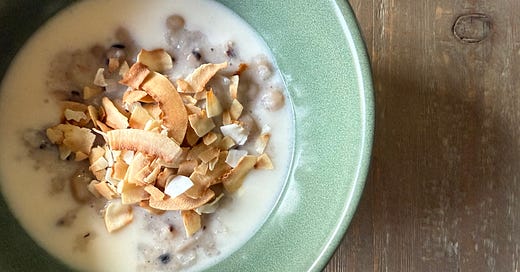



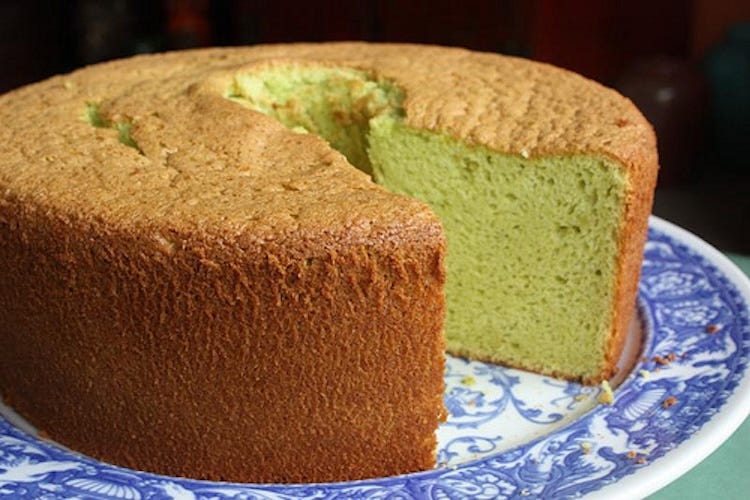


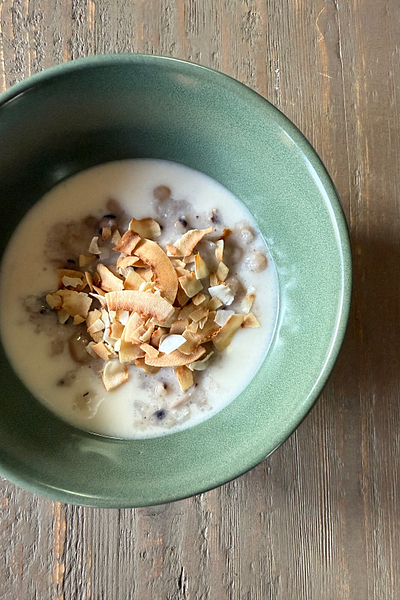
This is one of my favorite desserts that my friends from Saigon make. Now I can make it whenever I want!
I've never had this dessert. When I heard the word "đậu trắng", I assumed they use white beans, but they are black-eyed peas. At least in the North, they are called "đậu mắt cua" or "đậu mắt ngọc". I often incorporate legumes in my diet but I have no idea what to do with them to be honest :).